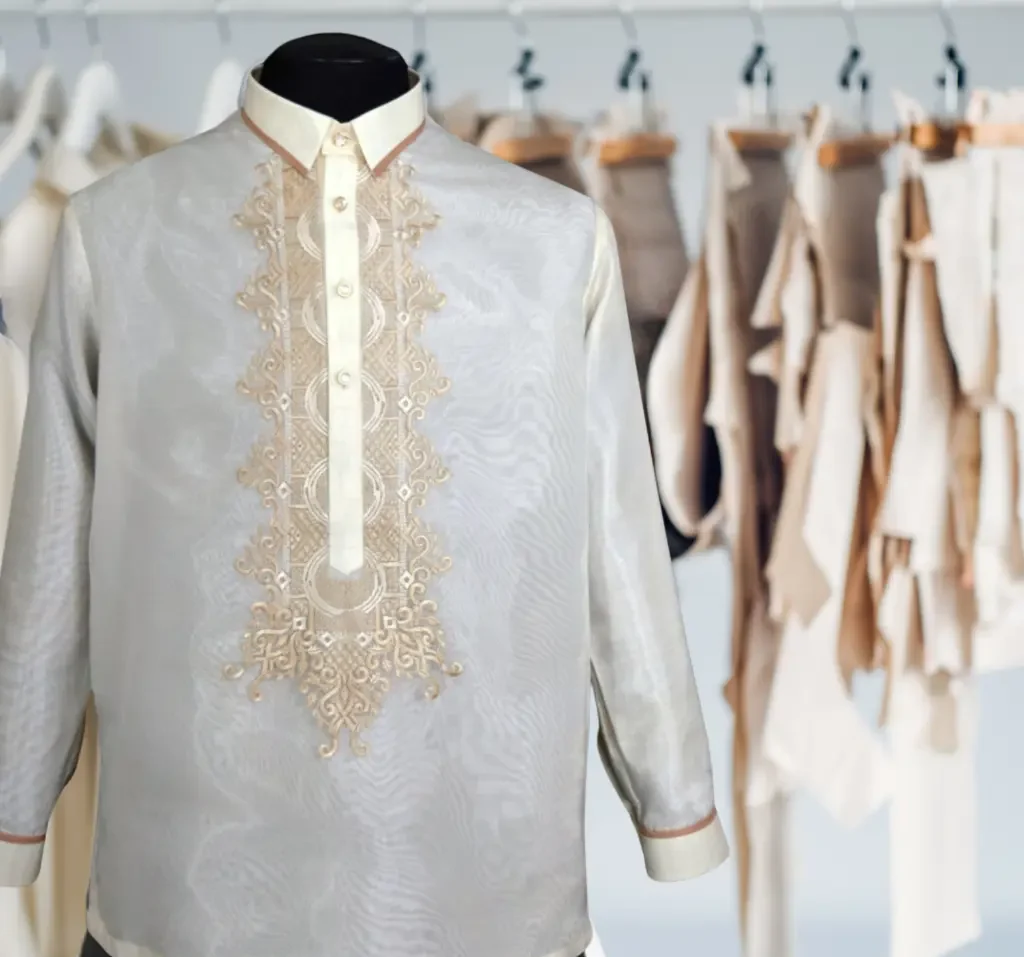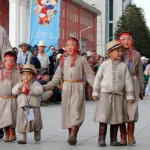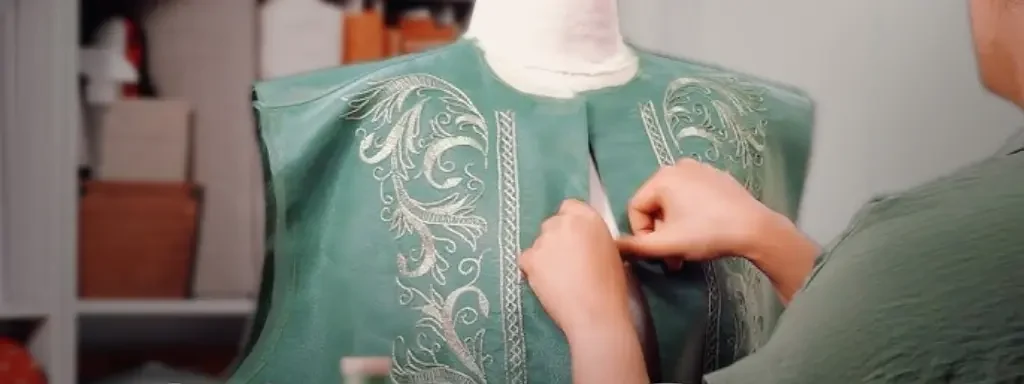What is the Barong Tagalog?
The Barong Tagalog is a traditional Filipino garment renowned for its elegance and cultural significance. Worn primarily by men, it is a lightweight, embroidered long-sleeved shirt made from sheer fabrics such as piña (pineapple fiber) or jusi (banana or silk fibers). The Barong Tagalog is typically worn untucked, showcasing its intricate embroidery and design.
This garment is more than a piece of clothing—it represents the fusion of Filipino heritage, pre-colonial traditions, and Spanish colonial influences. It is often associated with formal events, weddings, and national ceremonies, symbolizing respect and pride for Filipino identity.

A Brief History of the Barong Tagalog
Pre-Colonial Roots of Filipino Attire
Before the arrival of Spanish colonizers, early Filipinos wore baro (a loose shirt) and bahag (a loincloth) for daily activities. These garments, usually made from woven abaca or cotton, were simple yet functional, suitable for the tropical climate of the Philippines. Men and women alike adorned themselves with accessories like gold jewelry and tattoos to signify status or achievements.
Influence of Spanish Colonization
During the Spanish colonial period (1521-1898), Filipino clothing began to integrate Spanish elements. The baro evolved into the Barong Tagalog, incorporating embroidery, fine fabrics, and European-style collars. Spanish laws, however, required natives to wear the Barong untucked to distinguish themselves from Spaniards, adding to its unique style.
See also The Timeless Elegance of Mongolian Deel: Traditional Clothing Redefined
The Timeless Elegance of Mongolian Deel: Traditional Clothing Redefined
Evolution Through Time
In the post-colonial era, the Barong Tagalog became a symbol of nationalism and pride. Filipino leaders like José Rizal and President Manuel L. Quezon often wore it during public appearances, solidifying its status as the national attire. Over time, it has undergone stylistic modifications, but its core essence remains deeply rooted in Filipino culture.
Symbolism and Cultural Significance
The Barong Tagalog is not merely formal attire; it is a statement of identity. Each component carries meaning:
- Lightweight materials: Represent the tropical environment of the Philippines.
- Intricate embroidery: Highlights Filipino craftsmanship and artistry.
- Translucency: Symbolizes honesty and transparency.
- Design motifs: Often include indigenous patterns, flora, and fauna, celebrating Filipino heritage.
By wearing the Barong, Filipinos showcase their patriotism and respect for traditions while adapting to modern contexts.
How is the Barong Tagalog Made?

Selection of Materials
The Barong Tagalog is traditionally crafted from piña or jusi, both prized for their durability and sheen. Piña is derived from the leaves of pineapple plants and is known for its luxurious texture. Jusi, on the other hand, is made by blending banana fibers or silk, offering an alternative that is equally elegant. Modern variants sometimes incorporate polyester for affordability.
See also A Cultural Tapestry: The Timeless Elegance of Malaysia’s Baju Kurung
A Cultural Tapestry: The Timeless Elegance of Malaysia’s Baju Kurung
Hand Embroidery
The heart of the Barong lies in its embroidery. Skilled artisans meticulously create patterns, often inspired by nature or geometric shapes. These designs are typically concentrated around the chest, cuffs, and collar, ensuring they stand out.
Tailoring and Assembly
After embroidery, the fabric is cut and sewn into the characteristic long-sleeved silhouette. Expert tailors ensure that the Barong fits perfectly while maintaining its untucked aesthetic.
Variations of the Barong Tagalog
Piña Barong
Considered the finest type, the Piña Barong is lightweight, sheer, and breathable. Its delicate fabric requires careful handling, making it a popular choice for weddings and state functions.
Jusi Barong
The Jusi Barong offers a slightly sturdier and more affordable alternative to piña. It retains the elegance of traditional Barong designs while being accessible to a broader audience.
Modern Barong Tagalog
Today’s Barong Tagalog comes in various styles, colors, and cuts. Designers experiment with contemporary patterns, colored embroidery, and even shorter lengths, making it suitable for casual wear.
When is the Barong Tagalog Worn?
The Barong Tagalog is most commonly worn during formal occasions:
- Weddings: As the attire of choice for grooms and male guests.
- National events: Such as Philippine Independence Day and Araw ng Kagitingan (Day of Valor).
- State functions: Often worn by politicians and diplomats.
- Religious ceremonies: Adding a touch of tradition to baptisms, confirmations, and other rites.
Its versatility ensures that it remains relevant across generations.
How to Style the Barong Tagalog?
Pairing with Undershirts
A white camisa de chino is often worn underneath to highlight the Barong’s embroidery and provide modesty.
Pants and Footwear
The Barong is typically paired with formal black trousers and leather shoes. Contemporary styles may experiment with dark-colored jeans for a semi-casual look.
Accessories
Minimal accessories, such as cufflinks or a simple watch, complement the Barong without overpowering its intricate design.
Women’s Traditional Counterpart: The Baro’t Saya
While the Barong Tagalog is traditionally male attire, its counterpart for women is the Baro’t Saya. This ensemble consists of a blouse (baro) and a skirt (saya), often made from similar materials as the Barong. Like the Barong, it is a symbol of Filipino heritage and grace.
Maintaining and Preserving a Barong Tagalog
Proper Storage
To maintain its delicate fabric, store the Barong in a cool, dry place away from direct sunlight. Avoid folding it to prevent creases and preserve its embroidery.
Cleaning Tips
Handwashing with mild detergent is recommended for piña and jusi fabrics. Professional dry cleaning may be required for heavily embroidered pieces.
Repairs and Alterations
Consult skilled tailors for any repairs or adjustments, ensuring the Barong retains its original quality and fit.
The Barong Tagalog in Modern Fashion
Global Recognition
The Barong Tagalog has gained international recognition for its unique design. It has been featured in fashion shows and worn by global figures, introducing Filipino craftsmanship to the world stage.
Fusion with Contemporary Trends
Modern designers incorporate Barong-inspired elements into casual clothing, blending tradition with everyday wear. This innovation makes the Barong accessible to younger generations.
Why the Barong Tagalog Matters Today
In a rapidly globalizing world, the Barong Tagalog serves as a reminder of the Philippines’ rich cultural history. Its enduring popularity underscores the importance of preserving national traditions while embracing modernity.
By wearing the Barong, Filipinos celebrate their identity, honor their heritage, and share their culture with the world, making it a timeless symbol of pride and elegance.